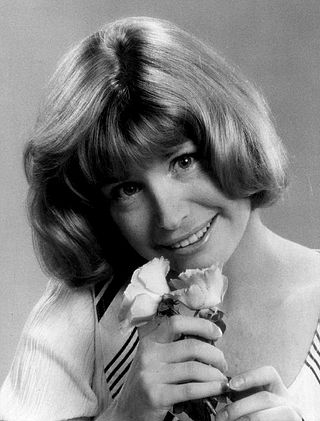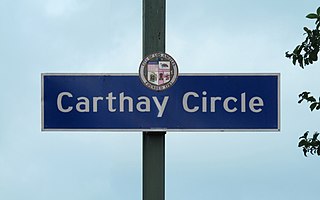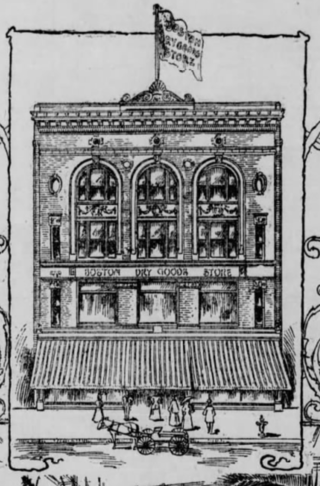
Bonnie Gail Franklin was an American actress. She is best known for her leading role as Ann Romano in the television series One Day at a Time (1975–1984). She was nominated for Emmy, Tony, and Golden Globe Awards.

Miracle Mile is a neighborhood in the city of Los Angeles, California.

Fox Theatres was a large chain of movie theaters in the United States dating from the 1920s either built by Fox Film studio owner William Fox, or subsequently merged in 1929 by Fox with the West Coast Theatres chain, to form the Fox West Coast Theatres chain. Fox West Coast went into bankruptcy and was sold to The National Theatres Corporation, led by Charles Skouras, on November 20, 1933, for $17,000,000.00. Eugene V. Klein later became CEO of National, and turned it into the conglomerate National General. Mann Theatres bought National General's theatres in 1973.

Carthay Circle is a neighborhood in the Mid-City West region of Central Los Angeles, California. Originally named Carthay Center, the neighborhood was later renamed after the famed Carthay Circle Theatre.

Wilshire Boulevard ('wɪɫ.ʃɚ) is a prominent 15.83 mi (25.48 km) boulevard in the Los Angeles area of Southern California, extending from Ocean Avenue in the city of Santa Monica east to Grand Avenue in the Financial District of downtown Los Angeles. One of the principal east–west arterial roads of Los Angeles, it is also one of the major city streets through the city of Beverly Hills. Wilshire Boulevard runs roughly parallel with Santa Monica Boulevard from Santa Monica to the west boundary of Beverly Hills. From the east boundary it runs a block south of Sixth Street to its terminus.

The Warner Grand Theatre is a historic movie palace that opened on January 20, 1931. It is located in San Pedro, Los Angeles, California, at 478 West 6th Street.

The Pellissier Building and adjoining Wiltern Theatre is a 12-story, 155-foot (47 m) Art Deco landmark at the corner of Wilshire Boulevard and Western Avenue in Los Angeles, California. The entire complex is commonly referred to as the Wiltern Center. Clad in a blue-green glazed architectural terra-cotta tile and situated diagonal to the street corner, the complex is considered one of the finest examples of Art Deco architecture in the United States. The Wiltern building is owned privately, and the Wiltern Theatre is operated by Live Nation's Los Angeles division.

Stiles Oliver Clements was an architect practicing in Los Angeles and Southern California.

The Paley Center for Media, formerly the Museum of Television & Radio (MT&R) and the Museum of Broadcasting, founded in 1975 by William S. Paley, is an American cultural institution in New York with a branch office in Los Angeles, dedicated to the discussion of the cultural, creative, and social significance of television, radio, and emerging platforms for the professional community and media-interested public.
The Nederlander Organization, founded in 1912 by David T. Nederlander in Detroit, and currently based in New York City, is one of the largest operators of live theaters and music venues in the United States. Its first acquisition was a lease on the Detroit Opera House in 1912. The building was demolished in 1928. It later operated the Shubert Lafayette Theatre until its demolition in 1964 and the Riviera Theatre, both in Detroit. Since then, the organization has grown to include nine Broadway theaters – making it the second-largest owner of Broadway theaters after the Shubert Organization – and a number of theaters across the United States, including five large theaters in Chicago, plus three West End theatres in London.
S. Charles Lee was an American architect recognized as one of the most prolific and distinguished motion picture theater designers on the West Coast.

Golden Gate Theater is a California Churrigueresque-style movie palace built in 1927 on Whittier Boulevard in East Los Angeles, California. In 1982, it was listed on the National Register of Historic Places. The theater closed in 1986; the retail building built around it was damaged in the 1987 Whittier Narrows earthquake and demolished in 1992. The remaining theater building was left vacant for more than 20 years as preservationists fought with owners and developers over the future of the building. It was finally converted into a drugstore and reopened in 2012.

The Broadway Theater District in the Historic Core of Downtown Los Angeles is the first and largest historic theater district listed on the National Register of Historic Places (NRHP). With twelve movie palaces located along a six-block stretch of Broadway, it is the only large concentration of movie palaces left in the United States. The same six-block stretch of Broadway, and an adjacent section of Seventh Street, was also the city's retail hub for the first half of the twentieth century, lined with large and small department stores and specialty stores.
Jack Irving Schwarz was an independent producer of low-budget feature films in the 1940s and 1950s.

Percy Augustus Eisen (1885–1946) was an American architect. He is primarily known for his work in Los Angeles with Albert R. Walker as Walker & Eisen.

The Sterling Plaza is a historic building in Beverly Hills, California.

Wilshire/Rodeo is a planned heavy-rail subway station in the Los Angeles County Metro Rail system. It is currently under construction as part of the D Line Extension project, in Beverly Hills, California. Construction started in 2018 as part of phase 2 of the extension project. It is slated to open in early 2025.

















